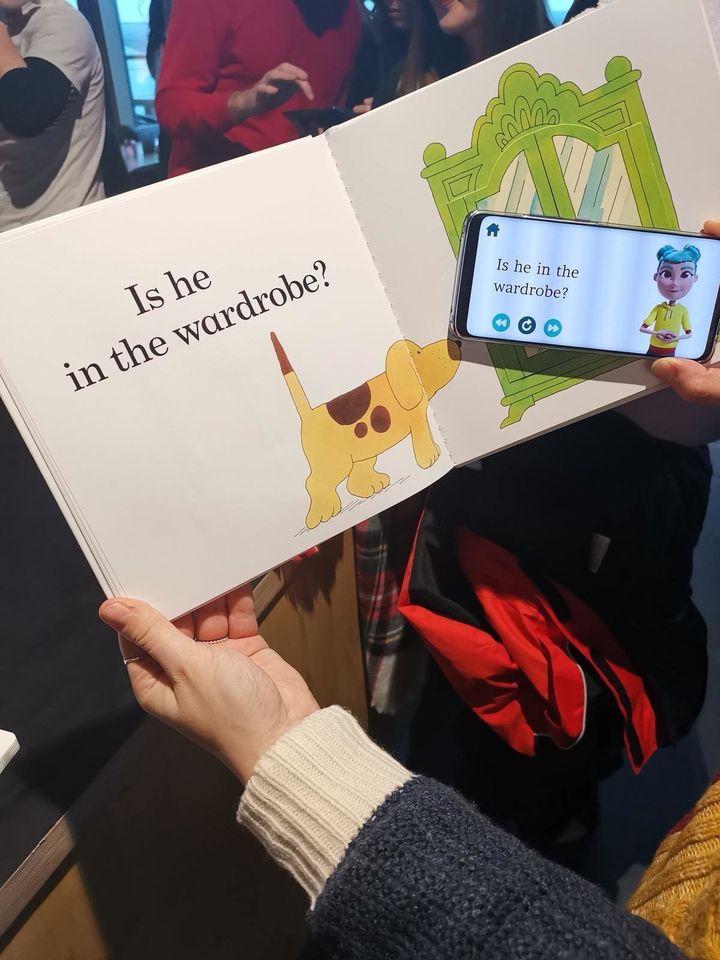There’s something magical about the moment you tuck your child into bed, ask them to choose a book and enter the world of storytime together. It’s a bonding experience like no other – and one that plenty of families take for granted.
Deaf children often miss out on this bedtime ritual altogether. And because of that lack of early reading, 70 per cent of deaf children arrive at school already behind on their development, according to the British Deaf Association.
The BDA estimates that 48 per cent of deaf children who speak and 82 per cent who use sign language are reading below their age level. At Christmas, a time where there are so many magical stories, this couldn’t be more poignant.

Deaf children struggle to read because they find it difficult to match words with sounds or signs. On top of this, they may also find it hard to concentrate on reading for long periods if they don’t understand, miss out on conversations contextualising words, or lack the support they need to learn sign language, says Jessica Reeves, campaigns manager at National Deaf Children’s Society (NDCS).
In 2017, City University of London released research that found the British education system is neglecting the needs of severely and profoundly deaf children – over half of the deaf children in the study who communicated using spoken language and four fifths of those who signed had reading difficulties at least as severe as those faced by hearing children with dyslexia.
With 90 per cent of deaf children born to hearing parents, early intervention is crucial for families during the critical period of language acquisition, according to Aine Jackson from the BDA.
“Deafness is not itself a learning disability, and there is no reason why deaf children should not develop at the same pace.””
What is being done at the moment to help them? “In short, not enough,” says Jackson. “78 per cent of deaf children attend mainstream schools with no specialist provision in place. Deafness is not itself a learning disability, and so there is no reason why deaf children should not develop at the same pace.”
Jackson knows from the BDA’s own beneficiaries that giving parents the resources and dedication to meet the language needs of their child produces great outcomes – those children often outperform even hearing children.
So what resources can parents use during this critical stage of learning?
There are brands trying to tackle this problem and open up books to all children. When looking to identify an area in which tech could make a positive difference, the telecommunications company Huawei challenged itself to help kids growing up in a silent world. And the result: StorySign.
This new app – created with Aardman, the animators behind ‘Wallace and Gromit’ – allows kids to read stories with their parents through a signing character, Star, who scans a book’s pages and signs the words back.
Huawei worked with Mark Wheatley, who leads the European Union of the Deaf, on the project. The partnership between parent and child is crucial to development, said Wheatley, and it’s especially important for kids to feel that connection at bedtime.
“We want to make sure that’s established,” he signed during the launch of StorySign in Lapland, Finland, adding that the StorySign app works equally for parents, who “can learn as they watch it.”
The app uses AI intelligence and character recognition to translate words into sign language for kids to read. Parents open the app and choose a book from the StorySign library. When they point the camera at words on the page, the avatar Star signs the words back to the child. As she does this, the words she signs are highlighted on the page, to help both the parent and child understand the connection between the word and the sign – and its syntax or word order.

“It’s really natural reading experience and gives both child and parent capability to read and sign together,” said Peter Gauden, product manager for Huawei. “A way to open the world of books to deaf children.”
Creating the app was a complex process – sign language is contextual and relies on facial expressions as much as it does movement, so Aardman couldn’t simply create a database of signs for Star to use. Instead, the company used motion capture: they filmed a woman signing the books and turned her movements and expressions into animation. Each book took a month to film and the library now includes such classics as Eric Hill’s ‘Spot The Dog’.
The app works, said Wheatley, because it’s gets children’s brains working and sets foundations for their future. “Most people think children who sign will never learn to speak, but that’s not true. Sign language is a great foundation for them to make those connections and once they’ve got that, the world is theirs.”
StorySign is just one step in the right direction – and Huawei is now partnering with deaf charities for funding so it can create more books for the StorySign library. But how else can we bridge the gap?
Aine Jackson stresses the need for early intervention but also “deaf education created from strong bilingual principles [that] will enable children to make links between words and signs or concepts earlier on and develop at the same pace as their hearing contemporaries.”
Meanwhile, local councils must work to ensure that every deaf child in their area receives the funding they need to succeed when they start school, says Jessica Reeves at the NDCS. “With the support of their parents, specialist teachers and classroom assistants, there is no limit to what a deaf child can achieve.”
The StorySign app is available from Android stores on 3 December.
Amy Packham travelled to Lapland, Finland with Huawei’s Mate 20 Pro.